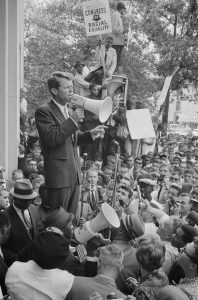Imagine running across a field. You’re tired and out of breath. You’ve been in what seems like an endless game. From sun up to sundown you’re running and fighting to make a goal. To some, it may seem like a game, but not to you. To you, it’s part of your culture, your religion, and, to you, the outcome matters.
Lacrosse was first played by Native American tribes in different regions of North America. There were many different versions of the game, rules, numbers of players, and sizes of the fields that would change depending on the tribe. Names of the game also varied, and included Creators’ Game, Baggataway, and Tewaaraton, which translates to “little brother of war.”1

The name that we know today as lacrosse came about in 1636 when French Missionary Jean de Brebeuf compared the shape of the sticks used by players of the game to a bishop’s crozier, which is ‘‘crosse’’ in French.2
For many Native American tribes, lacrosse wasn’t just a sport, but rather part of their culture and their religion. Since the game was very rough and people could be injured and even die while playing, the Iroquois used lacrosse as a way of training young men to be warriors, and the game was used to settle disputes without actually going to war. This is why lacrosse is nicknamed “little brother of war.”3 Lacrosse also had religious significance among some tribes. It was called the Creator’s Game, and it helped the players put their lives into perspective and teach lessons, some of the most valuable lessons being that everyone has struggles and opponents and the key to survival is friends and allies.
In the culture of the Iroquois, when a man dies, his lacrosse stick is buried with him. They believed that the first thing he would do when he wakes up in the afterlife is to take the stick from his coffin and begin playing that day.4

Native American lacrosse was often played on a stretch of land up to two miles long with sticks between 3-5 feet long made of wood and animal skin. A game could include between one-hundred to one-thousand players at a time. There was no set time to the games. The two teams would agree on a set amount of points and would play from sunrise to sunset until the amount of points was achieved.5 Violence and injuries were very common, and players would often walk away with minor cuts, broken bones, head injuries, and occasionally a death would occur.
Few people can claim to have experienced a Native American game of Lacrosse. Artist George Catlin had a passion for learning about Native Americans, and how they lived. He once said that “If my life is spared, nothing shall stop me short of visiting every nation of Indians on the Continent of North America.” He attended a major Choctaw lacrosse game in 1834. In his time there, he recorded everything that he saw and described how the game was set up from the length of the field and deciding where the goals would be places, to how each team was set up. He described how the night before the match both teams danced and chanted all night. Each team had a medicine man who chanted incantations to strengthen their team and weaken the other. He recorded his experiences through paintings and writings.6
Lacrosse is a sport that has a beautiful history and carries a meaning that many of us will never be able to understand. To Native Americans, lacrosse was a sport, a teaching tool, a religion, and a way to connect their cultures with other tribes.7 Today the history and meaning behind lacrosse has been lost, and to many it has become just another sport played for recreation and friendly competition.
- The Gale Encyclopedia of Fitness, 2012, s.v. ‘”Lacrosse,” by David E. Newton. ↵
- Salem Press Encyclopedia, 2017, s.v., “Lacrosse,” by Justin D. Garcia. ↵
- Thomas Vennum Jr., “American Indian Lacrosse: Little Brother of War,” The Journal of American Folklore 108, No. 427 (1995): 98-99. ↵
- S. L. Price, “Pride of a Nation,” Sports Illustrated 113, no. 2 (2010): 60-71. ↵
- Stanley A. Freed, “Lacrosse yesterday and today,” Cobblestone 15, no.9 (1994): 32. ↵
- Joanna Shaw-Eagle, “Catlin saves vanishing Indians on canvas,” The Washington Times, January 4, 2003. ↵
- John Seabrook, “Gathering of the Tribes,” New Yorker 74, No. 26, (August 1998): 30. ↵



154 comments
Vianey Centeno
You did a fantastic job at informing us about the background of one of the most popular sports in America. I could never have imagined how significant a role this sport played in history. The fact that it was a means of achieving a stronger theological and moral foundation also caught my attention. Knowing that not all individuals are aware of this heritage is a bit depressing.
Eugenio Gonzalez
Lacrosse was a dangerous sport in which people lost their lives or suffered injuries. The author explains how Lacrosse is more than a game for Native Americans. According to Native Americans, Lacrosse involved their culture and religion. Native Americans used Lacrosse as a way of training for future warriors; the training was used to prepare young men to become warriors. Lacrosse had different names; some of those names were ”little brother war” and” Creators game”. The author highlights the belief that Natives Americans had in the afterlife where a man would be buried with his lacrosse stick, but once he woke up, he would take the stick and play Lacrosse. The author also tells us how Native Americans would prepare before having a game and what rituals they used to strengthen their team.
This theme connects to the class because it discusses how things were before Europeans arrived in the new world. It is more probable that these events happened before the colonization period or in its early stages. I would say that this theme fits with describing the civilizations in the new world.
The author does a great job of making the article compelling and making the reader maintain their interest to find out more information. Another thing that I considered is that the author did a great job choosing quality images that gave readers an idea of what a Lacrosse field looked like back then. The quality images also helped the article have more life.
Gabriela Chavarria
This article really goes into detail to explain the background of lacrosse and how even though we associate it with being just a game the natives made more use of it when they started it. We know Lacrosse for being a sport people like to play but the author included good information about how the Natives used it was to make their men stronger for war and explained the importance of it to their culture. It also tells us that this was a way of settling situations for them instead of just going straight into a huge war.
Rafael Portillo
To the author: Thank you for the enlightenment of lacrosse and all its history. Most of the time I do not enjoy reading about history or facts or anything that has to do with the past. But this article really caught my attention, the way it was well written and informed really gave me the energy to actually read and understand it. Most of my high school friends played lacrosse, so to be able to learn about the background will really help me understand the game like they do. I really liked the images you attached. Being able to explain how the sticks used to look and the adding an image was well thought out.
Shecid Sanchez
Reading this as a person who knows nothing about lacrosse it came as such a shock. Its incredible how lacrosse came form such a culture and religious way for the Native Americans, but now it’s seen as just one of many sports out there. The way this article was written it really grasped your attention and made you asking more questions and wanting to know more even though it did such great job of informing us on the culture.
jess sanchez
Reading this as a person who knows nothing about lacrosse it came as such a shock. Its incredible how lacrosse came form such a culture and religious way for the Native Americans, but now it’s seen as just one of many sports out there. The way this article was written it really grasped your attention and made you asking more questions and wanting to know more even though it did such great job of informing us on the culture.
Dejah Garcia
This article was very informative, I was able to receive information about the Cultural impact that lacrosse had on Native Americans. The imagery at the beginning of the article had my attention when I read, “ Imagine running across a field. You’re tired and out of breath. You’ve been in what seems like an endless game. From sun up to sundown you’re running and fighting to make a goal”. I believe you also used other elements in your article. What stood out to me the most was the translations you had between Tewaaraton And little brother of war.
Gabriella Parra
This is so interesting! I’m incredibly shocked to learn that lacrosse is a Native American sport and so important to the Iroquois. I have always thought of lacrosse as a European sport like rugby or croquet. At first I was surprised at how much injury natives were willing to endure for this game, but the same can be said for American football culture. It’s beautiful how the game had a religious and educational importance as well.
Kimberly Rivera
The article really drew me in mostly with the descriptive introduction and how it transitioned into the main point of the article. As someone who is not into any sports or pay attention to the history behind it I found it quite interesting how Lacrosse held such a high importance to the culture and religion of the Native Americans community. I want to also say that the usage of the images after each section really tied in well with each segment.
Kenneth Cruz
This author did an outstanding job in educating us on the history of one of America’s most well-known sports. I would’ve never begun to imagine how much historical significance this sport really had. I also found it very interesting that it was a tool to gain a more religious and moral background. It is a little disheartening to know that not everyone is informed of this history.